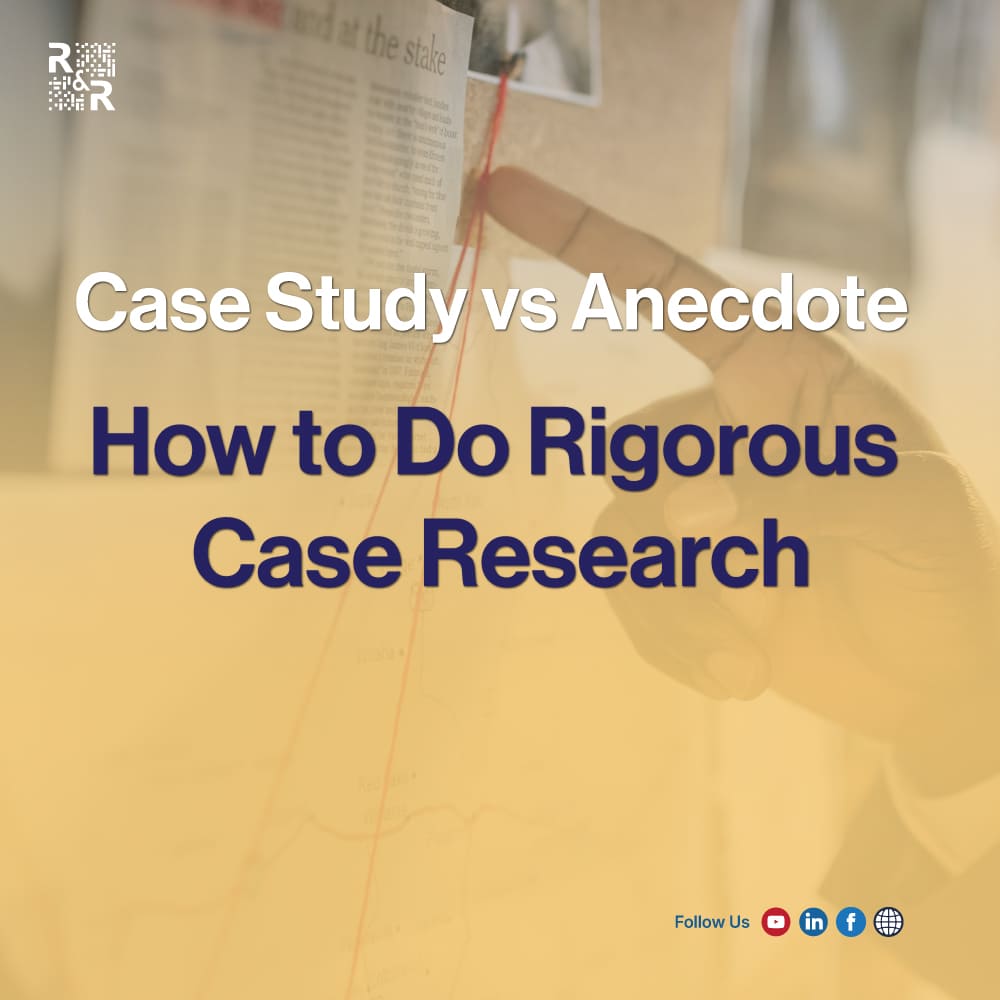Why the Distinction Matters in Research
In academic and policy research, the term “case study” is too often misused as a glorified anecdote. But a true case study isn’t only about telling a story — it’s about systematic inquiry into real-life phenomena using evidence, logic and theoretical framing.
Researchers who blur the line between case illustration and case analysis risk producing conclusions that sound convincing—but lack scientific rigor. When a case becomes simply a narrative of “what happened” rather than “why and how it matters”, the research value declines dramatically.
What a Rigorous Case Study Requires
Strong Theoretical Grounding
A rigorous case study links empirical work to theory. As noted by Crowe et al., the case study approach is “particularly useful when there is a need to obtain an in-depth appreciation of an issue … in its natural real-life context.” PMC
Without connecting the case to broader theoretical propositions, the work remains descriptive, not analytical. Scholars like Flyvbjerg argue that misunderstandings often arise when case studies lack a clear theory contribution. arXiv
Robust Data Triangulation
High-quality case research uses multiple data sources: documents, interviews, observations, artefacts. According to JMLA, rigor in case studies “comes from the research design … (a) study’s questions, (b) propositions, (c) unit of analysis, (d) logic linking the data to propositions, and (e) criteria for interpreting the findings.” jmla.mlanet.org
Relying on a single source renders the study vulnerable to bias and weak replicability.
Deep Contextualisation
Context matters. A case study must situate phenomena in their socio-political, institutional or temporal settings. As the article “Case Studies: more than simple anecdotes” notes: “Case Studies should act as instructive examples … they should indicate the course of treatment the patient underwent … and contextualise the clues.” Nature
Neglecting context can hinder meaningful generalisation or transferability.
Proper Documentation & Replicability
Transparent protocols help other researchers assess, replicate or extend the work. Without clear chains of evidence and documentation, a case study risks being anecdotal. Crowe et al. emphasise the importance of planning, design, interpretation and reporting.
Thoughtful Case Selection (Avoiding Bias)
Selecting a case simply because it’s convenient or high-profile can introduce selection bias. The “famous case” may illustrate, but it may distort insight. Researchers must justify case choice, define unit of analysis and maintain theoretical relevance. Wikipedia on case studies emphasises that case selection should aim for rich information, not just typicity. Wikipedia
Common Pitfalls When Researchers Use Case Studies as Anecdotes
- Descriptive instead of analytical: Saying “XYZ happened” without explaining why or how.
- Single source dependency: Using only interviews or self-reports, missing document or observation triangulation.
- Ignoring context: Failing to show how institutional or cultural environment shaped outcomes.
- Poor documentation: Making methods opaque, limiting replication or scrutiny.
- Convenient case selection: Picking high-visibility cases for ease, but sacrificing theoretical or generalisable value.
- Overgeneralisation: Treating one case as proof of broad trends when scope conditions aren’t defined. The study on scientific vs anecdotal evidence emphasises: “Relying exclusively on anecdotal evidence can lead to overgeneralisation and bias.” SciencePOD
Best-Practice Framework for Scholars & Institutions
When you design your next case-based research project, ensure you follow this checklist:
- Formulate research questions grounded in theory (not just “what happened”).
- Define the unit of analysis clearly (individual, organisation, event).
- Choose cases based on theoretical relevance, variation and replicability potential.
- Use multiple data sources (documents, interviews, observations, artefacts).
- Maintain a chain of evidence: show how data leads to propositions, analysis and conclusions.
- Document procedures: sampling, coding, analysis, limitations.
- Situate the case in its context: organisational, cultural, temporal.
- Conduct cross-case comparisons where feasible (to test concepts/ boundaries).
- Present findings in terms of both empirical illustration and theoretical contribution.
- Publish or share protocols, data (where permissible) and methodological transparency.

Conclusion – Making Your Case Study Evidence-Driven
Anecdotes inspire curiosity; case studies build evidence. The difference lies not in how interesting the story sounds — but in methodological discipline, transparency, theory-linkage and data robustness.
At Research & Report Consulting we guide scholars and institutions to move beyond descriptive storytelling. We focus on case designs that are rigorous, replicable and theory-driven — so your research truly advances knowledge and policy.
How will you ensure your next case-based project meets the standards of rigorous research rather than settling for anecdote?
References
- Crowe S et al., “The case study approach … in its real-life context.” PMC.
- “Distinguishing case study as a research method from …” JMLA
- Solomon J., “Case Studies: more than simple anecdotes.” Nature Medicine.
- “The Comparative Study of Anecdotal vs Scientific Evidence.” SciencePod
- “Case study.” Wikipedia
Want research service from Research & Report experts? Please contact us.
experts? Please contact us.

